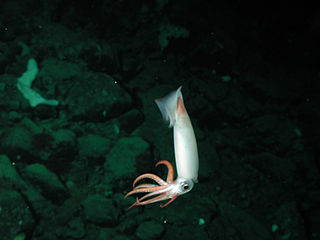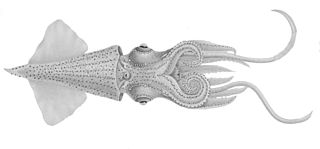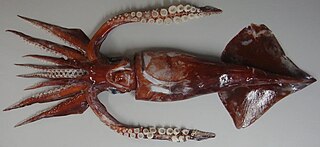
A squid is a mollusc with an elongated soft body, large eyes, eight arms, and two tentacles in the superorder Decapodiformes, though many other molluscs within the broader Neocoleoidea are also called squid despite not strictly fitting these criteria. Like all other cephalopods, squid have a distinct head, bilateral symmetry, and a mantle. They are mainly soft-bodied, like octopuses, but have a small internal skeleton in the form of a rod-like gladius or pen, made of chitin.

The Gonatidae, also known as armhook squid, are a family of moderately sized squid. The family contains about 19 species in three genera, widely distributed and plentiful in cold boreal waters of the Pacific Ocean. At least one species is known from Antarctic waters, and two from the North Atlantic. The genus Eogonatus was created for the species known as Eogonatus tinro because it did not have hooks on the tentacular club and it has 5 rows of teeth on the radula. Molecular studies in allozymes and mitochondrial DNA have indicated that this species nests within the genus Gonatus, although other authorities treat it as a synonym of Gonatopsis okutanii.

The Mastigoteuthidae, also known as whip-lash squid, are a family of small deep-sea squid. Approximately 20 known species in six genera are represented, with members found in both the mesopelagic and bathypelagic zone of most oceans. Originally described by Verill in 1881, it was later lowered by Chun (1920) to a subfamily (Mastigoteuthinae) of the Chiroteuthidae. However, Roper et al. (1969) raised it back to the family level, and this has not been changed since. The taxonomy of this family is extremely unstable, and there have been at times one genus, two genera and four subgenera(Salcedo-Vargas & Okutani, 1994), two genera and several 'groups', five genera and one species with an uncertain placement, or six genera.

Berryteuthis magister, also known as the magister armhook squid, commander squid or schoolmaster gonate squid, is a medium-sized squid in the family Gonatidae. It is found in cold, high latitude waters of the North Pacific where it is among the most numerous squid species recorded.

Doryteuthis plei, also known as the slender inshore squid or arrow squid, is a medium-sized squid belonging to the family Loliginidae. It occurs abundantly in coastal waters of the Atlantic Ocean, from Argentina northward to North Carolina.

The Gonatus Onyx is in the class Cephalopoda, in the phylum Mollusca. It is also known as the Clawed arm hook squid or Black-eyed squid. It got these names from the characteristic black eye and from its two arms with clawed hooks on the end that extend a bit further than the other arms. It is a squid in the family Gonatidae, found most commonly in the northern Pacific Ocean from Japan to California. They are one of the most abundant cephalopods off the coast of California, mostly found at deeper depths, rising during the day most likely to feed.

Histioteuthis reversa, commonly known as the reverse jewel squid or the elongate jewel squid, is a species of cock-eyed squid, so called because the eyes are dissimilar. It occurs at moderate depths in the Atlantic Ocean and Mediterranean Sea and is also known from the Indian Ocean.
Lolliguncula brevis, or the Atlantic brief squid, is a small species of squid in the Loliginidae family. It is found in shallow parts of the western Atlantic Ocean.

Illex coindetii, commonly known as the southern shortfin squid or broadtail shortfin squid, is a species of neritic squids in the family Ommastrephidae. They are found in the Mediterranean Sea and on both sides of the north Atlantic Ocean.

Teuthowenia megalops, sometimes known as the Atlantic cranch squid, is a species of glass squid from the subarctic and temperate waters of the northern Atlantic Ocean. They are moderately sized squid with a maximum mantle length of 40 cm (16 in). Their very large eyes are the source for the specific name megalops. Like other members of the genus Teuthowenia, they are easily recognizable by the presence of three bioluminescent organs (photophores) on their eyeballs.
Taonius borealis is a glass squid belonging to the genus Taonius. It is found in the North Pacific Ocean.

Taonius belone is a glass squid belonging to the genus Taonius from the family Cranchiidae. It occurs in the northern subtropical and in the tropical or equatorial waters of the Pacific and Indian Oceans.

Enoploteuthis leptura, the hooked enope squid, is a species of squid from the family Enoploteuthidae. It is the type species of the genus Enoploteuthis, which is in turn the type genus of the Enoploteuthidae.
Gonatopsis is a genus of squid from the family Gonatidae. They are characterised by the loss of their tentacles by the time they have reach the subadult stage. They have arms which have two series of hooks along the midline of the oral surface arms, the radula has five or seven teeth, the mantle can be muscular or flabby, fins are rhomboid or arrow shaped and they lack photophores. They are found in the North Pacific.

Gonatopsis borealis, the Boreopacific armhook squid, is a species of squid from the North Pacific Ocean. It is a member of the family Gonatidae. It is an abundant species which is currently caught mainly as a bycatch by fishing boats targeting other quarry. It is an important prey species for many commercially important species of fish, as well as for marine mammals.
Gonatopsis japonicus is a species of squid from the family Gonatidae. This species is restricted to the western North Pacific in the seas around the Japanese Archipelago.
Ornithoteuthis volatilis, the shiny bird squid, is a squid from the subfamily Ommastrephinae, the flying squids, of the family Ommastrephidae part of the pelagic squid order Oegopsida. It is a tropical and sub-tropical species which is widely distributed in the Indo-Pacific oceans. It is slightly larger than the closely related species Ornithoteuthis antillarum of the Atlantic Ocean.
The Angolan flying squid is a species of squid from the subfamily Todarodinae, part of the familyOmmastrephidae. Due to taxonomic confusion with the Antarctic flying squid the exact limits of its distribution are uncertain but it is thought to be restricted to waters off Southern Africa.

The Antarctic flying squid is a species of squid from the subfamily Todarodinae of the family Ommastrephidae, a family of pelagic squid from the order Oegopsida. It has a circumglobal distribution in the seas around the lower latitudes of the Southern Oceans.
The little flying squid is a species of squid, one of the arrow squids of the genus Todarodes, in the subfamily Todarodinae of the flying squid family Ommastrephidae. It is a small species from the waters around northern Australia and Indonesia.












